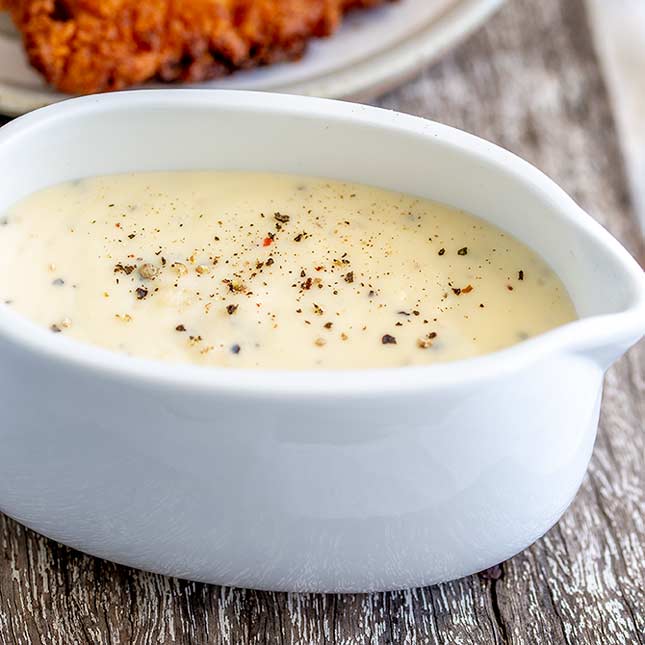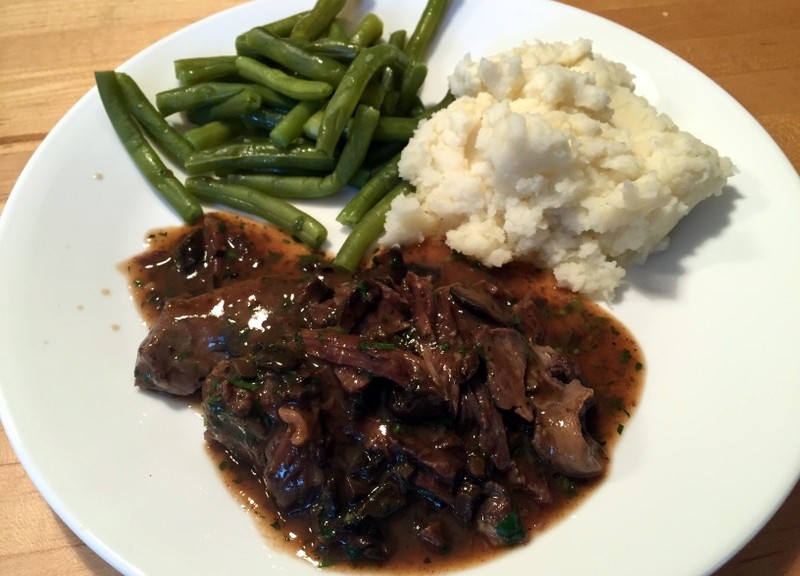W IS FOR WHITE GRAVY
By:
June 2, 2024

An installment in CONDIMENT ABECEDARIUM, an apophenic food-history series from HILOBROW friend Tom Nealon, author of the seminal book Food Fights and Culture Wars: A Secret History of Taste (2016 UK; 2017 US); and also — here at HILOBROW — the popular series STUFFED (2014–2020) and DE CONDIMENTIS (2010–2012).
CONDIMENT ABECEDARIUM: SERIES INTRODUCTION | AIOLI / ANCHOVIES | BANANA KETCHUP / BALSAMIC VINEGAR | CHIMICHURRI / CAMELINE SAUCE | DELAL / DIP | ENCURTIDO / EXTRACT OF MEAT | FURIKAKE / FINA’DENNE’ | GREEN CHILE / GARUM | HOT HONEY / HORSERADISH | INAMONA / ICE | JALAPEÑO / JIMMIES | KECAP MANIS / KIMCHI | LJUTENICA / LEMON | MONKEY GLAND SAUCE / MURRI | NƯỚC CHẤM / NUTELLA | OLIVE OIL / OXYGALA | PIKLIZ / PYLSUSINNEP SAUCE | QIZHA / QUESO | RED-EYE GRAVY / RANCH DRESSING | SAMBAL / SAUERKRAUT | TZATZIKI / TARTAR SAUCE | UMEBOSHI / UNAGI SAUCE | VEGEMITE / VERJUS | WHITE GRAVY / WOW-WOW SAUCE | XO SAUCE / XNIPEK | YOGHURT / YEMA | ZHOUG / ZA’ATAR | GOOD-BYE TO ALL TZAT(ZIKI).

It’s so simple, yet white gravy makes so many delightful things extra delightful: chicken fried steak, biscuits, fried chicken, pork chops, sausage, grits.
Making things that are merely good better or great things amazing is the hallmark of a civilized society. If we are willing to settle for good, especially for breakfast, what other soul-crushing half-assery will we visit upon ourselves later in the day? Safer to just make some white gravy first thing in the A.M., ideally with the leavings from cooking sausage or ham, but still a treat made with butter and a roux, whole milk, salt and pepper, cayenne if you like that sort of thing. It’s the work of a few minutes but will remind you that there is more to life than carefully saving a few minutes just to collect in a sad sack to spend profligately on nothing good later in the day. Spend your minutes on gravy and your gravy-moistened soul will thank you ten times over.
White gravy is, of course, also delicious for dinner – pay close attention when you pan fry things around the dinner hour and the ghost of white gravy yet to come will start to appear in the leavings. A vision of a slightly happier you, gravy-bellied and well sated, shimmering in the pork, chicken, and beef fat in the bottom of that pan. Don’t question the vision; roux and whisk and be well.

No one’s colonialism was more tightly bound to condiments than England’s. There is a subtext to condiment use — a yearning and a hopefulness, but also a sort of externalized self awareness; we know what we lack. Wow-wow sauce is an expression of that — a frenzied attempt to fill what is, in the case of 19th-century middle-class British cuisine, a yawning chasm of need.
Britain in the early 19th century: Despite a few hiccups in the U.S., the whole world is their backyard, Napoleon defeated, Australians displaced, Sinhalese humbled, Irish put down, Iberia sorted, India under control. But why this feeling of emptiness at the center of it all? Shouldn’t Empire feel better, taste better? All those boiled and roasted meats blending together into a gray and insipid haze from which there was no obvious escape.
Enter William Kitchiner. Crucially, he wasn’t a professional cook but an enthusiastic amateur and idler who claimed to be an optician. So he wasn’t burdened with any dogmatic professional knowledge or preconceived notions of taste and flavor, but was able to look at British cuisine as it was, to judge its deficiencies and suggest remedies. The remedies that he suggested in The Cook’s Oracle (1817) were baroque: a 28-ingredient “Magazine of Taste” held in a large wooden box on your table (box construction instructions included) containing four eight-ounce bottles, sixteen four-ounce, and eight two-ounce bottles of spices, powders, sauces, essences, and juices from around the world. In addition to instructions for assembling your own magazine, The Cook’s Oracle contained over 200 recipes for sauces and catsups — including Wow-wow sauce.
Wow-wow is made with a butter roux, vinegar, mushroom catsup, port, mustard, parsley. and pickles. Kitchiner also suggests, if you need more flavor: capers, shallots or shallot wine (shallots steeped in sherry, a favorite trick of Kitchiner’s to get shallot flavor without ending up smelling of shallots like a poor person), essence of anchovy, basil, tarragon, elder, horseradish, or burnet vinegar.
You can sense, reading the recipes in The Cook’s Oracle generally, and the recipe for Wow-wow sauce specifically, Kitchiner’s worry as the recipe unfolds: It’s not going to be enough, it couldn’t possibly ever be enough flavors to take that boiled lump of beef and turn it into a meal fit for a citizen of the British Empire. But what you like about him is that that never deters him from trying — again and again — from fiddling with flavors, commingling sauces and condiments, the contents of his garden, every shelf in the larder, in the boundless hope that somehow the next combination of flavors will succeed. So very many of Kitchiner’s sauces were variations of a theme, i.e., umami plus whatever – a base of soy or mushroom catsup or anchovy with an array of sour, savory, and salty flavors fanned out around.
After all, England might have been a nation of shopkeepers, as Napoleon (maybe but probably not) had it, but they weren’t shopkeepers without needs and they had the means, if not the gustatory perspicacity, to pursue those needs. Just 20 years later, Lea & Perrins commercialized Worcestershire sauce, a similar, but homogenized, version of Kitchiner’s wow-wow and a sauce that finally scratched the constellation of itches that Britain was afflicted with.
Without Kitchiner and his mad paroxysms in search of flavor, though, who knows if Worcestershire, or its viscous cousin HP Sauce, would ever have been made?
TOM NEALON at HILOBROW: CONDIMENT ABECEDARIUM series | STUFFED series | DE CONDIMENTIS series | SALSA MAHONESA AND THE SEVEN YEARS WAR | & much more. You can find Tom’s book Food Fights & Culture Wars here.
